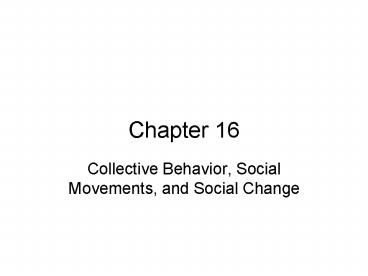Collective Behavior, Social Movements, and Social Change - PowerPoint PPT Presentation
1 / 16
Title:
Collective Behavior, Social Movements, and Social Change
Description:
Chapter 16 Collective Behavior, Social Movements, and Social Change Chapter Outline Collective Behavior Social Movements Social Movement Theories Social Change in the ... – PowerPoint PPT presentation
Number of Views:412
Avg rating:3.0/5.0
Title: Collective Behavior, Social Movements, and Social Change
1
Chapter 16
- Collective Behavior, Social Movements, and Social
Change
2
Chapter Outline
- Collective Behavior
- Social Movements
- Social Movement Theories
- Social Change in the Future
3
Collective Behavior
- Definition of social change
- Collective behavior is voluntary, often
spontaneous activity that is engaged in by a
large number of people and typically violates
dominant-group norms and values. - Collective behavior can take various forms,
including crowds, mobs, riots, panics, fads,
fashions, and public opinion.
4
Factors That Contribute to Collective Behavior
- Structural factors that increase the chances of
people responding in a particular way. - Timing.
- Breakdown in social control mechanisms and
corresponding feeling of normlessness.
5
Types of Crowd Behavior
- Casual crowds - people who happen to be in the
same place at the same time. - Conventional crowds - people who come together
for a scheduled event and share a common focus. - Protest crowds Definition
- Public opinion
6
Types of Crowd Behavior
- Expressive crowds - people releasing emotions
with others who experience similar emotions. - Acting crowds - collectivities so intensely
focused that they may erupt into violent
behavior. TQ
7
Explanations of Crowd Behavior
- Contagion Theory - People are more likely to
engage in antisocial behavior in a crowd because
they are anonymous and feel invulnerable. - Social unrest and circular reaction - the
discontent of one person is communicated to
another who reflects it back to the first person.
8
Social Movements
- Revolutionary social movement
- Alternative social movement
- Relative deprivation
- Structural conduciveness (promote) movements are
more likely to occur when a person, class, or
agency can be singled out as the source of the
problem.
9
Explanations of Crowd Behavior
- Convergence theory - focuses on the shared
emotions, goals, and beliefs people bring to
crowd behavior. - Emergent norm theory - crowds develop their own
definition of the situation and establish norms
for behavior that fits the occasion.
10
Social Movement Theories
Relative Deprivation People compare achievements, become discontent and join social movements to get their fair share.
Resource Mobilization People participate in social movements when the movement has access to key resources.
11
Social Movement Theories
New Social Movement Focus on sources of social movements, including politics, ideology, and culture.
Social Construction Theory Frame Analysis Used to determine how people assign meaning to activities and processes in social movements.
12
Value-Added Theory
- Conditions required for social movements to
develop - People are aware of a problem and engage in
collective action. - Society cannot meet expectations for taking care
of the problem. - Spread of a belief of possible solutions to the
problem.
13
Value-Added Theory
- Events reinforce the beliefs.
- Mobilization of participants for action.
- Society allows the movement to take action.
14
Types of Social Movements
- Reform movements seek to improve society by
changing an aspect of the social structure. - Revolutionary movements seek to bring about a
total change in society. - Religious movements seek to produce radical
change in individuals and typically are based on
spiritual or supernatural belief systems.
15
Types of Social Movements
- Alternative movements seek limited change in some
aspect of people's behavior. - Resistance movements seek to prevent or undo
change that has already occurred.
16
Stages in Social Movements
- Preliminary stage - people begin to become aware
of a threatening problem. - Coalescence stage - people begin to organize and
start making the threat known to the public. - Institutionalization stage - organizational
structure develops.

